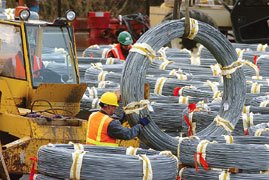 |
| Wired. Contractor for Washington state suspension bridge scrambles for more cable after some 1,000 coils show signs of oxidation. and must be tested . |
About 20% of the 4,800 coils of cable meant for the new Tacoma Narrows Bridges 2,800-ft-long suspension span are unusable and will have to be replaced. Linea Laird, project manager for the Washington Dept. of Transportation, says it is too early to determine costs and delays associated with the wire problem.
Inspectors for the $850-million, 5,400-ft-long Gig Harbor crossing are still performing tests and inspections on almost 1,000 wire coils that show some oxidation to ascertain if they are usable, says Laird. Another 1,400 coils showed no oxidation. Some 1,200 wires have already been spun. "Were confident that the wire already installed is corrosion-free," says Claudia Cornish, project spokeswoman.
While possible improper packing of the Asian-manufactured wire may have caused the corrosion, "it is premature to say for sure," Cornish adds.
Each .196-in.-dia, four-mile-long, galvanized-steel wire on a coil is part of a "bundle" or strand. There are 464 wires in each bundle, and 19 bundles in each of the suspension cables. On Nov. 12, a cable-spinning operator noticed oxidized deposits on one of the stored wires, says Laird. Inspectors then began checking the rest.
Tacoma Narrows Constructors, the locally based joint-venture design-builder led by Kiewit Pacific and Bechtel Infrastructure, declined to comment. Laird says work is continuing on hanging suspender ropes and spinning usable wires. "We have no cost estimate for the testing so far," she says.
The wire was supplied by Kiswire, a South Korean company, using Japanese steel. The zinc-coated coils are delivered individually wrapped either in plastic or in plastic and paper lining. Each wire was unpacked only when ready for spinning, says Laird. Zinc can oxidize if the just-galvanized items are stored while moist or if too tightly packed.
TNC is trying to negotiate contracts with various manufacturers to replace the unusable wires. The teams $615-million lump-sum, design-build contract makes it responsible for any additional costs.
Laird says there is no specific milestone deadline for the cable spinning but it must be completed for deck placement to begin. Placement of 120-ft-long sections of orthotropic steel deck is scheduled to begin in May. In the month-long operation, the 46 deck sections will be lifted into place by gantry cranes on barges, then connected to the suspender cables and welded into place, says Laird.
The project, which to date has been on schedule and on budget, is scheduled for completion in 2007 (ENR 10/13/03 p. 20).

Post a comment to this article
Report Abusive Comment